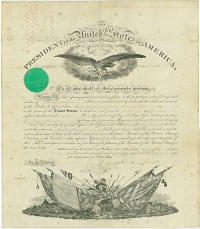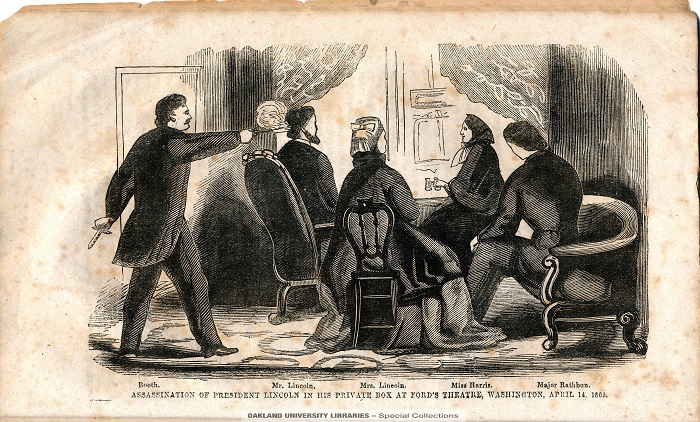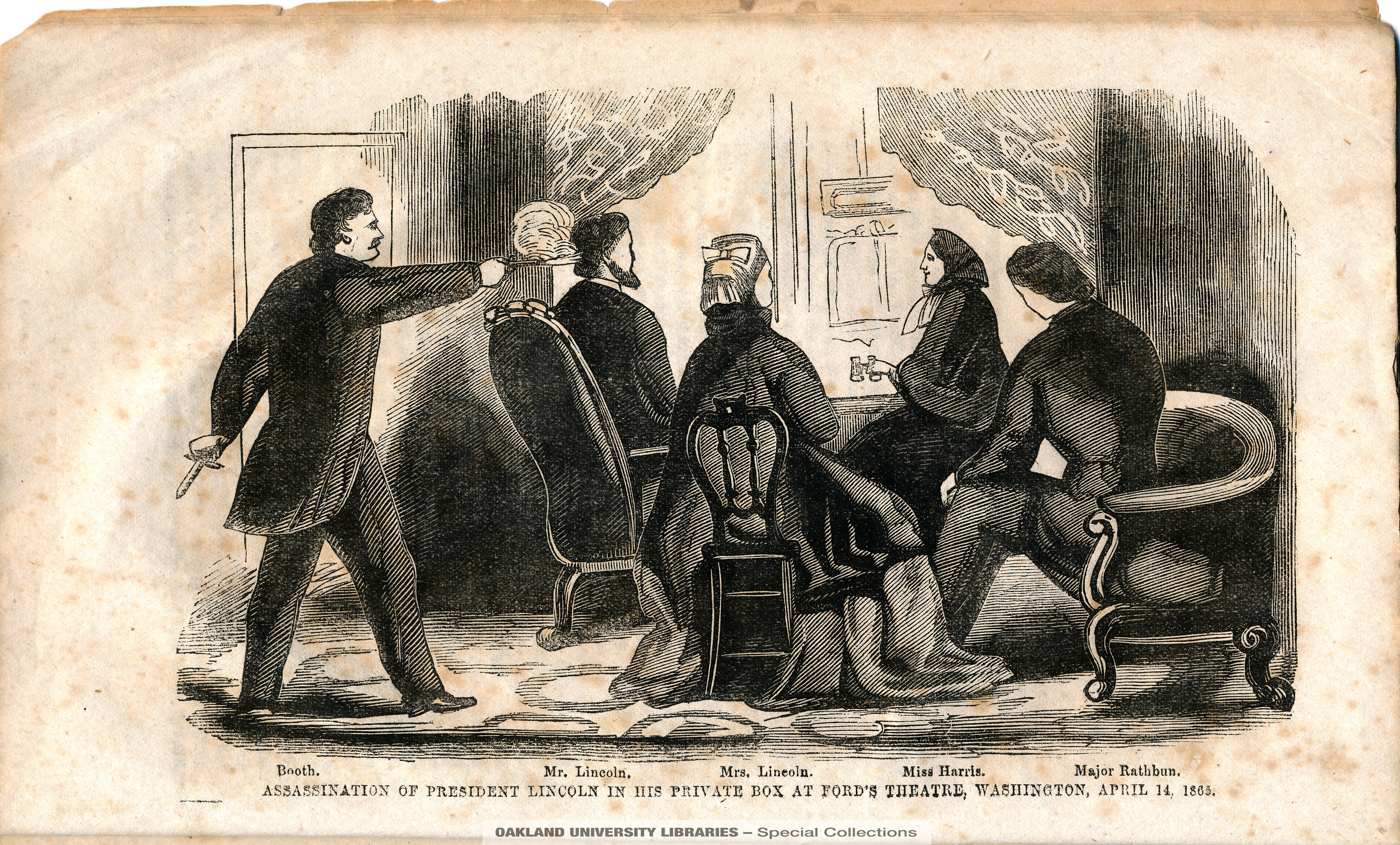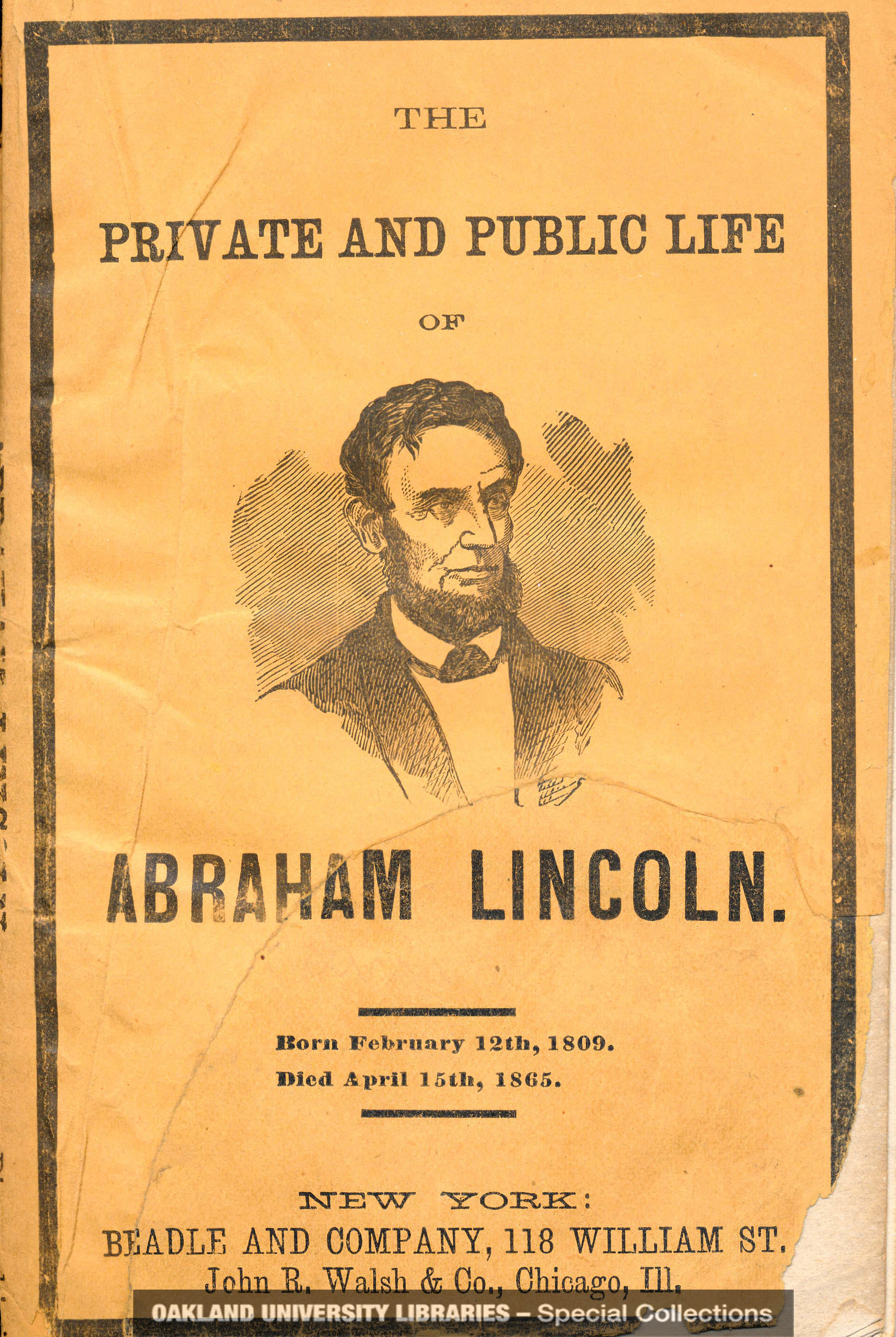William Springer Collection
This is a large and diverse collection of Civil War materials. Oakland University acquired it from Mr. Springer, the editor of the New Center News published in Detroit, and an avid collector of Civil War materials.
The collection consists of some 2000 volumes, pamphlets, manuscripts, newspapers, as well as artifacts that celebrate and commemate President Lincoln -- busts of Lincoln, medals, plates, and much more...
Biographical Note
Scope and Contents
Books
Pamphlets and Ephemera
Catalogs and Bibliographies
Manuscripts
Scrapbooks
Graphic Materials
Historical Newspapers
Frederick L. Black Papers
Bernhardt Wall Collection
See complete inventory (PDF)
A few items from the collections are part of the
Remembering Lincoln digital collection
Access
Access is available by request and by appointment only.
Biographical Note
Born in an Austrian-Croatian village near Karlstadt, Austria, William Springer emigrated to the United States to live with a miner uncle in Pennsylvania in 1913. He enrolled in a correspondence course in electrical engineering but interrupted it to enlist in the US army for 3 years. Upon his discharge he became a door-to-door salesman for advertising items.
In 1932 he came to Detroit, took up residence near Wayne State University and found a job in direct mail advertising. In January 1933 he developed his company into a small tabloid called “This Week,” which later became “Monday Morning” and then the ”New Center News.” It chronicled the life of people working in the area of the GM and Fisher Buildings. It is still published today by Springer Publishing.
For 42 years he was an avid collector of Lincolniana. His interest was aroused when Dr William Barton, a minister and Lincoln authority, presented him with a volume about Lincoln in 1927. He started amassing books, but had to sell them during the Depression. He started again in 1933, and it developed into the large collection that would eventually be donated to Oakland University.
In 1952 he founded the Abraham Lincoln Civil War Roundtable of Michigan and served two terms as its president. He was associated with major Lincoln collectors and experts in the nation, such as Carl Sandburg, Bernhardt Wall (creator of the etched book Following Abraham Lincoln), Thomas Starr, Stewart McClelland (President of Lincoln Memorial University), Edgar DeWitt Jones (another reverend and Lincolnian), Frederick Black, and Louis Warren (historian and archivist at the Lincoln National Life Foundation).
For more information:
- “The Legend of William Springer: A Brief Pictorial Autobiography of a Boy and the Man,” New Center News Dec. 25, 1972 (in William Springer biographical file, Oakland University Archives and Special Collections)
- The William Springer biographical file (OU Archives and Special Collections) consists of newspaper clippings, copies of addresses and media statements that Springer collected and send to Oakland University with his collection. It also includes a list of outstanding books in the collection.
- James Jay Monaghan, Lincoln Bibliography (Illinois State Historical Library, 1943-45) and many other bibliographies in the Springer collection.
- Journal of the Abraham Lincoln Association
Scope and Contents
Mr. Springer sold his collection to Oakland University in 1969. This included his books, pamphlets, photos and other graphics, newspapers, memorabilia, manuscripts, numerous sculptures and other objects. Two distinct collections were included with the purchase: the Frederick L. Black Papers and the Bernhardt Wall collection.
Books
The book collection contains about 2,000 volumes amassed by Springer over forty some years. They cover all aspects of history related to Lincoln: there are books on Lincoln’s ancestry, parentage and childhood, boyhood and young manhood. There are Lincoln’s own writings and speeches, as well as books dealing with his political and executive life. There are also books on slavery, the Union and Confederate armies, the Civil War, as well as Michigan and Detroit history of the mid 19th century.
Springer said his favorite book was The conspiracy trial for the murder of the president by court reporter Benjamin Perley Poore (1865-1866). He was also fond of Albert J. Beveridge’s Abraham Lincoln, the manuscript ed. (Houghton Mifflin, 1928) with an original leaf of Beveridge's manuscript bound in volume I, finely illustrated and complete with gravure frontispieces in each volume and four additional hand-colored frontispieces of the Lincoln Memorial. In The Life of Dr. Samuel A. Mudd, Nettie Mudd pleaded her father’s case in the Lincoln assassination conspiracy, using family letters and correspondence as well as John Wilkes Booth letters. The first edition has a frontispiece and several portraits.
Pamphlets and ephemera
Mr. Springer amassed a large collection of over 1,000 pamphlets and ephemera (such as event programs, menus, tickets) produced both during the time of Lincoln’s life and assassination, and later on, as commemorative publications.
The earliest pamphlet are from 1854: a lecture by Robert C. Winthrop, “Algernon Sidney: a lecture, delivered before the Boston mercantile library association, December 21, 1853” and an essay on the Nebraska question by abolitionist Theodore Parker, discussing the proposed Kansas-Nebraska bill.
Pamphlets from 1855-1865 document Abraham Lincoln’s political career and the politics of the time, including the 1860 and 1864 elections, the extension of slavery in the territories, and pro- and anti-slavery views. There is also a copy of the Opinions of Chief Justice Taney and Justice Curtis in the 1857 Dred Scott case (box 19). Some of the pamphlets are inscribed, such as the Account of the Ceremonies at the dedication of the Bigelow Monument, Worcester, Massachusetts, April 19, 1861. It is signed by Levi Lincoln, former Governor of Massachusetts and member of the House of Representatives, who was one of the personalities attending the event and helped create the National Republican (later Whig) Party in Massachusetts.
In the aftermath of Lincoln’s assassination a host of pamphlets were published to meet American citizens’ thirst for information regarding the life of the president, the plot to assassinate him, and the fate of the conspirators. Americans also mourned their president at church services and public meetings. The Springer collection has a large number of such pamphlets published in 1865-1866 in the form of biographies, addresses, or sermons. For example, The assassination and death of Abraham Lincoln by Abott A. Abott. Box 7 contains numerous eulogies.
The largest part of the pamphlet collection consists of pamphlets and ephemera from the 1870s to the 1960s (with the bulk covering the period from the 1920s-1940s). They include addresses and sermons delivered in different settings (academic, commemorative, political, or religious) and presented in various formats, including radio talk transcripts, newspaper clippings, typed copies and private editions. They deal with topics related to President Lincoln, the state of Illinois, slavery, the Civil War, the Confederacy, Lincoln commemorations, and even the national debate on segregation in the South in the 1920s - 1950s -- for example, Douglas Anderson’s Some Southerners: an impartial statement concerning certain mobbings of Negroes in Northern states by lawless invaders from the South, and the consternation these mobbings did not cause among northern politicians (1946).
The pamphlet collection contains numerous reprints of scholarly and popular articles, mostly from the 1920s-1940s. Many are by well-known Lincoln collectors, professional and amateur historians of the time such as J. B. Oakleaf, G. P. Hambrecht, E. Hertz, O. Eisenschiml, and H. E. Pratt. Some are privately printed publications and limited editions, and many are dedicated to Springer by the authors. There is also unpublished materials sent to Springer by G. P. Hambrecht (box 14). Some booklets were published by companies and businesses, others by governmental agencies such as the National Park Service. There are also numerous excerpts from the Congressional Record relating to Lincoln and Civil War history.
Other publications include poetry, museum and historical sites brochures, event programs, book announcements. Finally there are some reprints of well-known Lincoln documents and facsimiles.
The collection has been left in the order in which Mr. Springer brought to the library, based on his own organization scheme. Boxes 1-10 are organized by topic, and boxes 11-20 alphabetically by author. The latter cover similar topics, however. The majority of the materials in those boxes are publications by Lincoln scholars and collectors. Boxes 21 to 24 contain additional materials on related themes, as well as poetry and sheet music. Most items are in English but there are also a variety of foreign language publications from European countries.
Most of the items are cataloged, and can be found by searching the library catalog. However a few items of lesser significance are not cataloged such as menus and newspaper clippings. Those are noted in the inventory.
Tips: to see a list of the entire collection, enter "Lincoln pamphlet" in the search box of Library OneSearch.
Catalogs and Bibliographies
Antiquarian book catalogs, Lincolniana catalogs, and bibliographies.
Manuscripts
Miscellaneous manuscripts include:
- an autograph book (including the signatures of the members of Congress and appointees at executive agencies under the Buchanan, Lincoln and Johnson administrations)
- 4 pages of a hand-written, Civil War newspaper, the Arkansas Post (1862)
- Papers of Captain George H Starr (Company D, 104th New York Infantry) including a 1863-1864 diary about his time in confederate prisons and later autobiographical notes.
Scrapbooks
19th century scrapbook entitled “Lincolniana in the newspapers 1844-1864” (clippings from 1840s-1860s newspapers covering major political events and debates)
Civil War scrapbook, 1962 (newspaper and magazine clippings from the 1940s to 1960s)
Newspaper clippings portfolios on Lincoln's history and commemoration.
Graphic Materials
Miscellaneous collection of photographs, drawings, prints and other graphic materials representing Abraham Lincoln, his family, cabinet members and other contemporaries, as well as places, events and other subjects related to President Lincoln's life and career.
A detailed inventory of the graphics collection is available upon request at the Archives.
Historical Newspapers
Crisis (Columbus, OH) - Jan 31, 1861 to Jan 23, 1862
Detroit Daily Advertiser - 1860: Oct 10 and 30New York Daily Tribune - 1860: Dec 15; 1864: Dec 23; 1865: Apr 10, Jun 29, Aug 5
The Tribune Extra, Mar 5, 1861 (President Lincoln's inaugural address)
New York Herald - 1865: Apr 16, 17, 18, 19, 20, 21, 23, 24, 25, 26
New York Morning Courier and Enquirer / The World - 1861: May 1-4, 7, 9-11, 13. 15-18, 31; June 3-8, 10-15, 17-22, 24-28; July 2-4, 6, 9-13, 15-16, 18-20, 22-27, 29-30; Aug 1, 5-8, 12-13, 15-17, 24, 26; 1862: Jan 28, Feb 4, Aug 29; 1865: May 3
New York Times - 1864: June 9, July 9, Sep 26, Nov 9, Dec 7, 1864
Portland Daily Press, Apr 18, 1865
Frederick L. Black papers
Fred Black was a close assistant to Henry Ford who asked him in 1920 to investigate the death of John Wilkes Booth. Henry Ford had just been contacted by Finis Bates, author of The Escape and Suicide of John Wilkes Booth (1900), with a stranger offer. Bates told Henry Ford he had the mummy of Booth in his home, and was willing to sell it to him. Ford was intrigued but not fooled. Fred Black's investigation led to the conclusion that the mummy was not the body of Booth, and that Booth had been killed during his capture in 1865.
The Black papers contain the documents he collected during his 2-year investigation of the story (affidavits, newspaper clippings, photos, and more), They also include Black's personal notes and an unpublished manuscript narrating the result of his investigation.
For more information: Marie C Dye, “Fred L Black, In Memoriam,” New Center News, Nov. 22, 1971, p1
Bernhardt Wall Collection
Bernhardt Wall was a renowned etcher who produced etched books. Every page, including the text, was made from an etched copper plate. He would etch the plates but also hand print every page and bind the books himself. He never used a printing press. Of course, he had to etch the entire text backwards so he could print the mirror image. Wall’s work is unique because of the novelty of the fully etched book, and the time and effort it took to make every single one himself. As he put it himself, he had “the itch to etch”. Each edition was limited to 100 copies.
William Springer amassed a large number of Wall’s books but also correspondence and other materials from Wall, who was a close friend. The Wall collection therefore includes correspondence, clippings, photos and materials which were gathered by the artist during the production and placement of his works and which offer unique insight into his creative process.
Wall is famous for his pictorial biographies of historical figures such as Abraham Lincoln, Thomas Jefferson or San Houston. Wall etched places they had visited, as well as the people they knew and their personal belongings. He relied on photographs, narratives and other documents to draw as precise a rendering as possible. His etchings are so precise that they are valuable not only artistically, but historically as well. Some of the books in Oakland University’s collection contain extensive correspondence and other materials inserted in them, documenting their production and distribution.
Highlights of the book collection:
- Following Thomas Jefferson (1933) - Jane Wall’s copy. Contains letters, clippings and other documents. OU Special Collections has another copy of the set, which contains a thank you letter by Franklin D. Roosevelt. Wall was the etcher of several presidents, including FDR.
- Following Abraham Lincoln (1931-1942) -Wall was keenly interested in Abraham Lincoln. He began a biography of Lincoln in May 1931, and over the course of a dozen years, etched 85 volumes. OU has sets 6 and 14.
- Washinton Irving Footprints, by Virginia Lynch (1922)
Other items include:
- Etched Dedications - Presentation copy to William Springer signed by author.
- Following General Sam Houston - mss, presentation copy to William Springer
- Jane Wall's Prints: a scrapbook assembled by Wall's wife that includes Wall etchings
- Bernhardt Wall's scrapbook of background materials for the book on the U.S.S. Maine. Wall was an active member of the United Spanish War Veterans.
In addition the collection includes sketches and samples used by Wall to prepare for his books. There are also a few additional photos and letters documenting Wall’s background research for his major work, Following Abraham Lincoln. Finally, there are 3 copper plates used in illustrating Following Abraham Lincoln, including one cancelled Lincoln plate (1924).
Remembering Lincoln Exhibit
Oakland University participated in the Remembering Lincoln digital archive, an online archive showcasing collections dedicated to Lincoln's death and commemoration, hosted by Ford's Theater.
Created by / Updated on July 25, 2019 by Name








